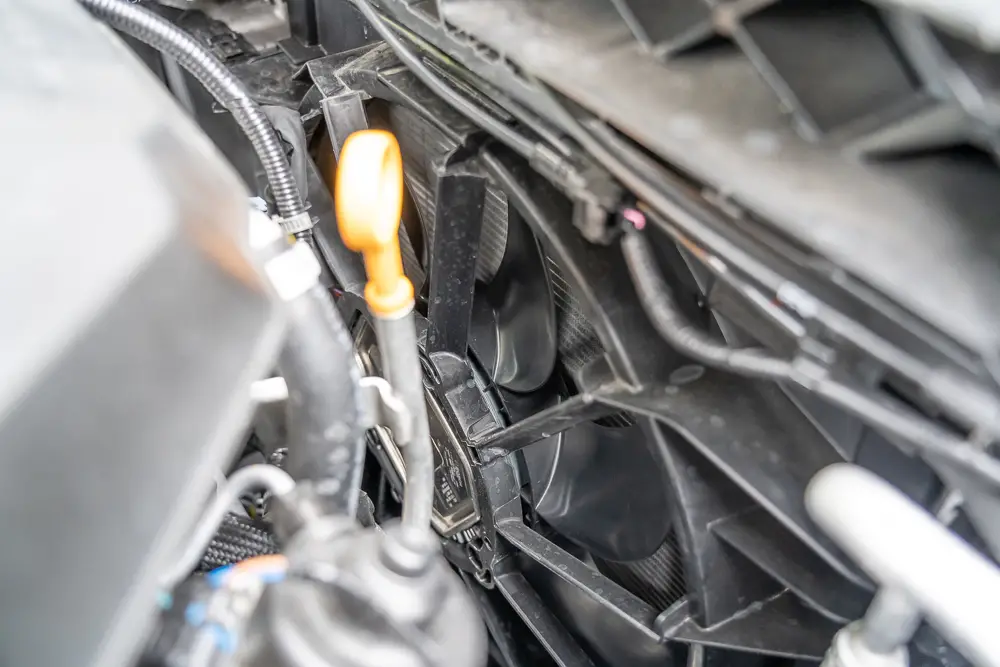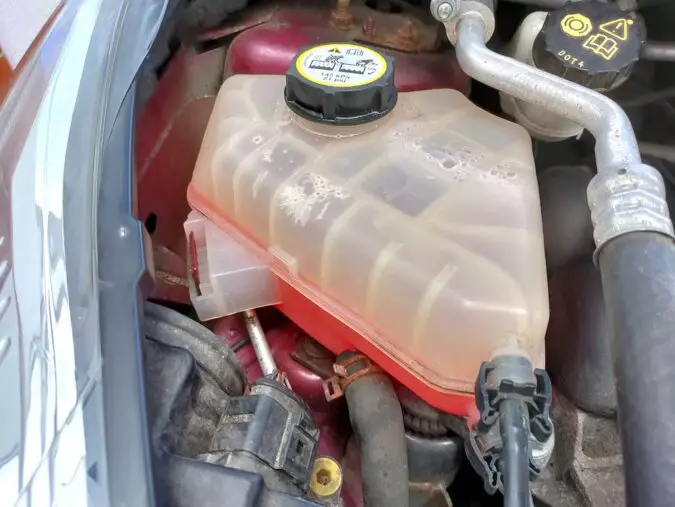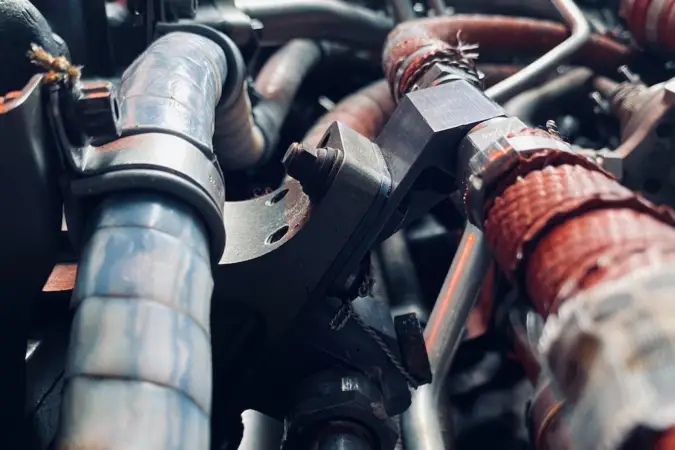Like any other components in your car, the radiator will eventually age and need repairs. It’s just a part of the car ownership experience. And that’s why we like to make these articles about car repair guides to make your car repair process easier. So, how much does the radiator repair cost? Well, it ranges anywhere from $100 to $800 depending on your car’s make and model, the severity of the damage, and what needs to be done.
We’ll guide you on radiator repair costs, as well as everything else you need to know about it.
- How A Radiator Works
- Signs Of Failure
- Repair/Replacement Costs
- DIY Fixes
- Considerations
- Final Conclusion
- FAQs
What Does A Radiator Do
Before we get to the radiator repair cost, we always like to explain how the car component in question works. This will give context on why repairs might need to be done and the whys behind the costs.
A radiator is a heat exchanger device that’s used either for heating an area or cooling fluids or coolants that are fed to it. In the case of cars, radiators are for cooling the coolant fluid in your car that helps to keep your car’s engine operating at the optimum temperature. It’s usually around 100 – 120 degrees Celcius.
The construction usually comprises either metal or plastic tanks at the top and bottom. The tanks are linked by a core with passageways for the coolant to flow through, sometimes called fins. When the coolant passes through the fins, the fins will absorb the heat from the coolant.
This cools the coolant down before it reenters the engine. The core is usually made from layers of metal sheets, but some radiators use aluminum as well. Using aluminum helps to save weight and cost, but it’s more difficult to repair.
The radiator is the heart of your car’s cooling system. Without a properly functioning radiator, your cooling system won’t be able to keep the engine cool. This is because it won’t be able to dissipate heat from the engine’s coolant. This will lead to overheating, and if left unserviced, will lead to internal engine damage.
Engine Cooling
So, how does the cooling system works? What role does the radiator play? Well, your car’s cooling system consists of several components: the water pump, the thermostat, the hoses, the radiator cap, and of course, the radiator.
The coolant in your car will sit in the radiator and reservoir tank. When the engine is running, the water pump will circulate the coolant throughout your engine. This allows the coolant to carry heat away from the engine.
After the engine warms up, the thermostat will open the main bypass valve, which allows coolant to circulate into the radiator. Inside the radiators are metal (or sometimes aluminum) fins that will dissipate the heat from the coolant. The system also usually has a fan sitting either in front or behind the radiator to help dissipate heat.
After passing through the radiator, the coolant’s temperature will drop. It will then travel into the engine again via the water pump to keep the engine at the optimum operating temperature and prevent it from overheating.
While in operation, the system will become pressurized. The radiator cap regulates the pressure inside the system, and once it reaches a certain pressure, it will open a valve that allows coolant to be stored in the reservoir tank. This is why you shouldn’t open the radiator cap while it’s still hot. Hot coolant can burst out and can cause burns on your skin. Not exactly pleasant.
As you can imagine, when the radiator breaks, it won’t be able to dissipate heat from the coolant properly. This will result in hot coolants flowing through your engine which will lead to overheating. The radiator also protects the heater core, which is the device that allows warm air to blow when you turn on your car’s heater.
Cracked Radiator Symptoms
Since it plays such a major role in your car, there will be noticeable symptoms when your radiator needs repairs.
Radiator Repair Cost, Failure Symptoms #1: Overheating Engine
Since the radiator is the heart of your car’s cooling system, the most likely symptom will be an overheating engine. That being said, other components like a faulty water pump or thermostat can also make your engine overheat. So, if you’re driving and you notice the temperature rising, you will need to troubleshoot this to find out the exact cause.
Radiator Repair Cost, Failure Symptoms #2: Coolant Leak
If you see a puddle of liquid under your car, take a moment to check that puddle. If the liquid is brown and thick, you have an oil leak. Meanwhile, if it’s dark red, then you likely have a transmission fluid leak.
And if the liquid is bright red or green, then you have a coolant leak. Finally, if it’s just water then it’s no cause for concern. That’s usually just water from condensation in your car’s air-conditioning system.
If you have a coolant leak, it would be wise to check where the leak is coming from. Open your engine bay and see if you can spot the coolant leak. It can come from the radiator hoses, the water pump, or the radiator itself.
Regardless of where the leak is coming from, you will need to address this issue. A coolant leak will decrease the amount of coolant rapidly and can cause your engine to overheat. As mentioned, this will lead to internal and possibly very expensive damage to the engine.
Radiator Repair Cost, Failure Symptoms #3: Sludge In The Coolant
Under normal conditions, the coolant will always remain bright in color whether it’s green or red. If you open the radiator cap or the reservoir tank and notice there’s sludge or the coolant is turning a rusty or oil color, this is a sign of contaminant build-up in the radiator.
This is because your radiator will eventually build up rust, debris, and other contaminants inside it over the years. Usually, it will get worse after about 10 years. Contaminant buildup in the coolant can reduce its efficiency in cooling the engine, which will then cause the engine to overheat. Additionally, if the contaminants are circulating through the system, they can cause damage to other components like the hoses and the water pump.
To check this, simply open the radiator cap when it’s cool and check the color of the fluid inside it. If it appears to be dark or there’s sludge in it, then you may need to do a radiator flush. Additionally, check for specks of oil inside the coolant. This usually indicates a blown head gasket and you will need to address this immediately before it gets worse.
Radiator Repair Cost: Repair Or Replace
So, how much does a radiator repair cost? And do you need to replace or repair your radiator?
Radiator Repair Cost
Repairing a radiator usually means either sealing a leak or doing a radiator flush. It depends on what problems you have with your radiator. If you have sludge in your coolant, then a radiator flush will do your car good.
The process involves draining your car’s cooling system of all the coolant, then filling it with a mixture of water and cleaning solution. The car then will need to run for about 15 minutes to let the cleaning solution circulate throughout the cooling system, including into the radiator. After that, drain the system again and refill it with a new coolant (with some references on how to put antifreeze in your car).
If you’re doing this yourself, you can repeat the process a couple of times to ensure you clean the system thoroughly. If you want a repair shop to do it for you, it will cost you somewhere between $100 – $150.
Meanwhile, a small radiator leak can be repaired by using a block sealer like K-Seal. This will cover up the leak in your radiator, but keep in mind this will only work for minor leaks. To use it, simply insert the stop-leak fluid into the radiator or the coolant reservoir.
Then run the engine and keep it running until it gets to operating temperature. Afterward, check if the leak has been sealed. Sealing fluids should be able to cover up holes up to 0.635mm wide. Or, cracks that are 0.200mm wide and up to 12.00mm long.
Radiator Replacement Cost
If you have a cracked tank or big holes within the radiator, then you will need a full radiator replacement. Some repair shops may offer a fix, but at this point, you’re really better off replacing the entire radiator. It will save you money in the long run as a new radiator means you’re unlikely to encounter any more radiator-related problems anytime soon.
The exact cost will obviously vary depending on your car’s make and model. But as an example, a new radiator for a 2015 Toyota Corolla will set you back $324. The labor cost for a replacement job is usually around $250, so that adds up to about $574 for a radiator replacement.
Keep in mind that this is just an example, we found that for some cars the radiators only cost about $150 to purchase. But of course, if you drive a luxury or performance car, the radiator itself can easily exceed $500.
How To Replace The Radiator
While we don’t really recommend this, you can reduce your radiator repair cost (or replacement, in this case) by doing the job yourself. It’s not exactly as easy as changing your spark plugs, but with a bit of patience, you can do it yourself and save money on labor costs. A radiator replacement will usually take up an entire day to do.
But before we tell you how, we remind you again that this is quite a difficult job to do. So if you’re not sure of your mechanical skills, best leave a radiator replacement to a professional mechanic. That being said, here’s how to replace a radiator:
Radiator Replacement
- Raise the car with a jack and put it on jack stands.
- Make sure that the car is cold to avoid burn injuries.
- Drain the coolant from the cooling system. Most cars will have a valve to drain the coolant. If not, remove the lower radiator hose.
- Disconnect the radiator reservoir hose by twisting and pulling it.
- Remove the upper radiator hose by loosening the clamps using a screwdriver or pliers.
- Disconnect the fan connector and then remove the fan.
- Loosen and disconnect the transmission cooler lines (to learn more, check out our transmission cooler line diagram and the Ford F-150 transmission cooler line replacement).
- Remove the radiator mounting bolts, the owner’s manual may be able to provide you with where the mounts are. You may also need to remove the condenser mounting bolts.
- Once the radiator is loose, remove the old radiator.
- Install the new radiator, and reinsert and tighten the bolts. Afterward, reinstall the condenser mounting bolts.
- Reinstall the fan and the transmission cooler lines back in place, and then tighten them and reconnect the fan’s electrical connector.
- Reinstall the lower radiator hose and then the top one. Don’t forget to tighten the clamps back in place to hold them.
- Connect the radiator reservoir hose back in place, then refill the system with a new coolant. You may need around 2-3 gallons of coolant, check your owner’s manual on how much your car needs.
- Lower the car and then run the engine, to see if there are any leaks present. If not, pat yourself on the back cause you’ve done a good job!
This job will usually take an entire day to do. So clear your schedule if you’re planning on doing it yourself.
Radiator Repair Cost: Some Considerations
Got any more questions about your car’s radiator? We’ll try to answer as many as we can below:
How Long Can You Drive With A Cracked Radiator
That’s a hard no from us. Even the smallest leak can make your car lose coolant rapidly which will cause your engine to overheat. We cannot stress how bad it is for your car to overheat, it will result in very expensive damage.
Once your car gets internal damage, such as to the head gasket or the pistons, you will need to spend well over $1,000 to fix the damage. You may even need a full engine rebuild, and that can cost up to $5,000 for most cars.
If you have a dirty radiator and sludge in your coolant, you may still be able to drive. But this can also lead to overheating as your coolant won’t be as efficient in cooling the engine. Additionally, sludge or contaminants circulating can lead to damage to other cooling system components. It can damage the hoses, the water pump, and the thermostat.
A radiator hose will cost you about $160 to replace. Meanwhile, the thermostat will cost you about $180 on average. As for the water pump, it can cost up to $550 to replace. As you can see, these components are also very expensive to replace.
So, if you have sludge or dirt in the coolant, you should do a radiator flush before it affects or damages other components to avoid costly replacement jobs.
How To Maintain A Radiator
Maintaining your radiator is pretty straightforward. First, use the right coolant. Your car’s cooling system is designed to work with a specific coolant, and you can find this information in your owner’s manual on whether your car needs a particular type or color of coolant. It will also tell you how much coolant it needs.
Next, make sure the radiator cap is always sealed tight. The radiator cap is a small component, but it plays a great role in regulating pressure inside your car’s cooling system. If it isn’t tightened properly, it can damage your cooling system.
Radiator flushes may also be necessary but check with your owner’s manual and mechanic to verify how often your car needs a radiator flush. If your car has done over 100,000 miles, you may need to flush the system every 10,000 miles or so. This is because, after 5 years or 100,000 miles, the radiator will be dirty and needs more regular cleaning.
And finally, look out for any leaks in the system that may be present. Not only fluid will leak, but it can also allow air and contaminants to enter the system, causing damage to the radiator and cooling system. As mentioned, if you see red or green fluid underneath your car, check the cooling system for any leaks. If you see a leak, best to repair that immediately.
How To Tell If You Need A New Radiator
As we mentioned, various components can cause a car to overheat. So if you’re not sure it’s the radiator, you will need to troubleshoot it. We’ve written a guide on how to troubleshoot an overheating car, but here’s a quick guide:
- Check the coolant level and see if there are any leaks, first and foremost. If you see a leak and the coolant level is low, that’s your culprit. Fix or replace the leaking part, and refill the system with a new coolant.
- Check the radiator cap. If there’s a lot of rust, you may need a new radiator cap. They’re usually no more than $50 to purchase.
- Check the radiator fan, if it isn’t running, this can decrease the radiator’s ability to dissipate heat. If you have a mechanical fan that runs off the drive belt, then tighten or replace the belt if necessary. If you have an electrical fan and it’s broken, then you need a new fan. Also, check if the fan has damage.
- Verify the water pump is working. When the engine is cool, turn it on and open the radiator cap. If the coolant isn’t moving or flowing, this indicates your car water pump isn’t working properly. A mechanical water pump runs off the drive belt, so check if the belt is installed properly. If you have an electric water pump and it’s broken, you will need a new one.
- Coolant that isn’t flowing can also mean that the thermostat is broken and isn’t opening the valves properly. To check it, you will need to remove the thermostat and see if it’s working by putting it inside boiling water.
If all of the components above are working well, then it likely means you need a new radiator.
How Much Is A Radiator
The radiator repair cost varies between $100 – $1,000 depending on the severity of the problem. And of course, a radiator replacement is the most expensive one. Costing upwards of $800 for luxury cars, and about $500 on average for most cars. If the cost is too high, then you might be better off selling your car as-is (if you know how to sell a car privately).
So, should you repair or just sell your car? Well, we recommend checking the market value of your car. If your car’s value isn’t significantly higher than the repair cost, you’re probably better off selling it as-is. You will need to sell it at a lower value since you’re essentially selling a broken car, but this at least puts cash in your hand.
For example, if you need to spend $500 to replace the radiator, but your car only sells for around $1,500 or so, then you’re probably better off selling the car as-is. But if the resale value is much higher than that, then you should still consider replacing the radiator and keeping your car running.
Radiator Repair Cost: In Conclusion…
Your car’s radiator is an essential part of your car’s cooling system. A bad radiator won’t be able to dissipate heat from the coolant properly and can result in an overheating engine.
If your car runs hot, this can eventually lead to serious and expensive internal damage to the engine. This is why you shouldn’t ignore radiator problems or any cooling system problems for that matter. An overheating engine is not a healthy engine.
A radiator repair can be as simple as putting sealing fluid into the radiator or doing a relatively inexpensive radiator flush. But if the problem is severe enough or the radiator is damaged, then you will need to replace the entire radiator. In this case, you’re spending somewhere between $150 -$350 for most cars just for the parts.
FAQs On Radiator Repair Cost
If you’re still curious to learn more about a radiator repair cost, our FAQs here might help…
How Much Does A Radiator Cost
If your car’s radiator has been punctured or has cracks in it, you’ll then need to consider replacing it. Or, make do with repairing it, should the damage not be too severe. A radiator repair cost can vary wildly, going anywhere from $100 to upward of $800. If you need to re-seal a small puncture and flush (then re-fill) the coolant, it may cost you around $100 to $150 to do. These are relatively simple repairs. However, a full radiator replacement could cost you at least $500 and up, with a large part attributed to labor costs alone. This is at least cheaper than the thousands of dollars worth of fixes required should overheating occur.
How Does A Radiator Work
In a car, the radiator is a crucial component that’s necessary to keep the oft-toasty-hot engine cooled and kept within its safe operating temperatures. In essence, a radiator works as a heat exchanger. Once your engine gets hot enough, the thermostat opens, allowing chilled coolant to flow into the engine. This coolant would then absorb the heat from the engine, before then circulating back to the radiator. The radiator has numerous small passageways arranged as fins to help maximize its surface area. There, coolant would flow through those fins, where drag from the cold outside air would gradually cool them down as you’re driving along. Then, the whole cycle repeats.
How Much To Fix Coolant Leak
The cost of fixing a coolant leak will vary significantly depending on the component that failed, in the first place. And, the severity of that leak. If it’s a small leak or you happen to catch it and patch it up early on, it may cost you as little as $100. This would often involve replacing the many seals and gaskets where coolant might’ve leaked from. Or, re-sealing a small hole in the radiator. Even entire hoses won’t cost you too much. However, in the case of more serious faults, such as needing to replace the whole radiator or replacing a head gasket, can easily cost you close to or upward of $1,000 or more. It’s crucial that you find those leaks and fix them ASAP.
Where Is The Radiator In A Car
If you need to find your car’s radiator, all you need to do is pop open the hood. Then, the radiator should make itself known pretty easily. On most cars, the radiator can be found right at the front, just behind the front grille, and under the hood (near the hood latches, usually). Once you spot a large block of metal with fins in it, that’s your car’s radiator. You’ll also notice the radiator cap at the very top. The location of the radiator is ideal, as the front of your car encounters significant drag from all that air rushing through its fins (thus, cooling down the coolant that’s flowing within it), allowing it to maximize the heat exchange process.
How To Fix A Radiator Crack
Some cars these days come with plastic radiators instead of metal, which makes them pretty easy to crack over time due to aging and wear and tear. Once it does crack, you’ll now face a coolant leakage issue that can sometimes be rectified as easily as sealing in the crack. You can find dedicated radiator repair kits in most auto parts stores. It usually entails mixing some epoxy resin together and spreading that over the cracks. With a bit of heat, the epoxy would soon harden and seal off the cracks on the radiator. You might even consider sanding off excess epoxy to help smoothen the surface of the repaired area against the rest of the radiator.




